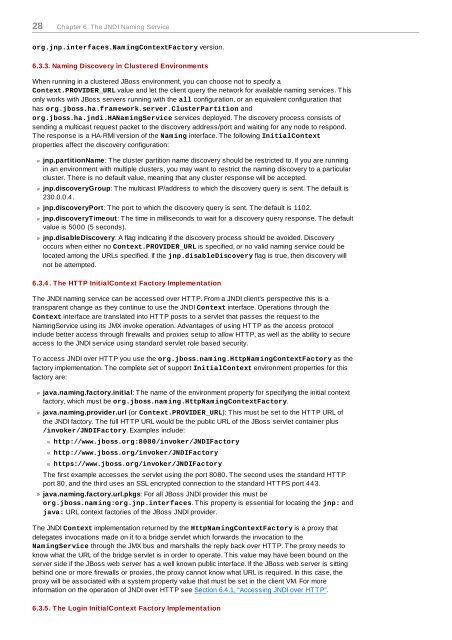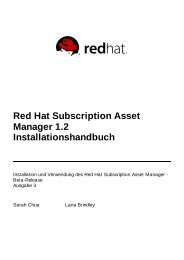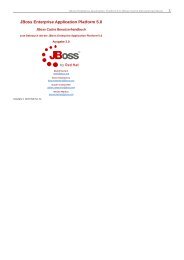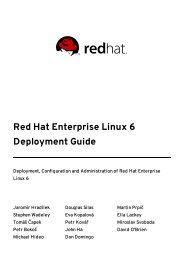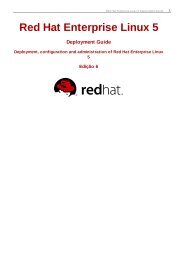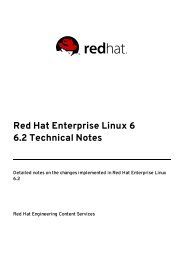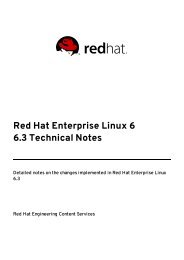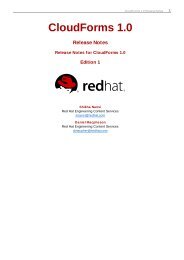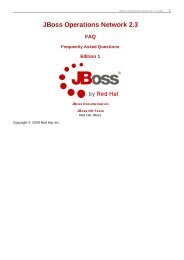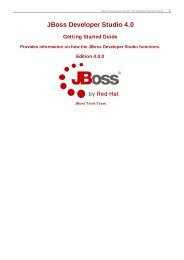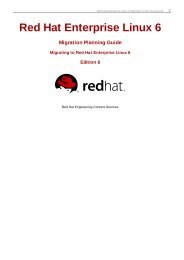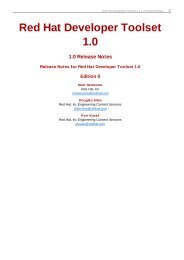JBoss Enterprise Application Platform Common Criteria Certification ...
JBoss Enterprise Application Platform Common Criteria Certification ...
JBoss Enterprise Application Platform Common Criteria Certification ...
Create successful ePaper yourself
Turn your PDF publications into a flip-book with our unique Google optimized e-Paper software.
28 Chapter 6. The JNDI Naming Service<br />
org.jnp.interfaces.NamingContextFactory version.<br />
6.3.3. Naming Discovery in Clustered Environments<br />
When running in a clustered <strong>JBoss</strong> environment, you can choose not to specify a<br />
Context.PROVIDER_URL value and let the client query the network for available naming services. This<br />
only works with <strong>JBoss</strong> servers running with the all configuration, or an equivalent configuration that<br />
has org.jboss.ha.framework.server.ClusterPartition and<br />
org.jboss.ha.jndi.HANamingService services deployed. The discovery process consists of<br />
sending a multicast request packet to the discovery address/port and waiting for any node to respond.<br />
The response is a HA-RMI version of the Naming interface. The following InitialContext<br />
properties affect the discovery configuration:<br />
jnp.partitionName: The cluster partition name discovery should be restricted to. If you are running<br />
in an environment with multiple clusters, you may want to restrict the naming discovery to a particular<br />
cluster. There is no default value, meaning that any cluster response will be accepted.<br />
jnp.discoveryGroup: The multicast IP/address to which the discovery query is sent. The default is<br />
230.0.0.4.<br />
jnp.discoveryPort: The port to which the discovery query is sent. The default is 1102.<br />
jnp.discoveryTimeout: The time in milliseconds to wait for a discovery query response. The default<br />
value is 5000 (5 seconds).<br />
jnp.disableDiscovery: A flag indicating if the discovery process should be avoided. Discovery<br />
occurs when either no Context.PROVIDER_URL is specified, or no valid naming service could be<br />
located among the URLs specified. If the jnp.disableDiscovery flag is true, then discovery will<br />
not be attempted.<br />
6.3.4 . The HTTP InitialContext Factory Implementation<br />
The JNDI naming service can be accessed over HTTP. From a JNDI client's perspective this is a<br />
transparent change as they continue to use the JNDI Context interface. Operations through the<br />
Context interface are translated into HTTP posts to a servlet that passes the request to the<br />
NamingService using its JMX invoke operation. Advantages of using HTTP as the access protocol<br />
include better access through firewalls and proxies setup to allow HTTP, as well as the ability to secure<br />
access to the JNDI service using standard servlet role based security.<br />
To access JNDI over HTTP you use the org.jboss.naming.HttpNamingContextFactory as the<br />
factory implementation. The complete set of support InitialContext environment properties for this<br />
factory are:<br />
java.naming.factory.initial: The name of the environment property for specifying the initial context<br />
factory, which must be org.jboss.naming.HttpNamingContextFactory.<br />
java.naming.provider.url (or Context.PROVIDER_URL): This must be set to the HTTP URL of<br />
the JNDI factory. The full HTTP URL would be the public URL of the <strong>JBoss</strong> servlet container plus<br />
/invoker/JNDIFactory. Examples include:<br />
http://www.jboss.org:8080/invoker/JNDIFactory<br />
http://www.jboss.org/invoker/JNDIFactory<br />
https://www.jboss.org/invoker/JNDIFactory<br />
The first example accesses the servlet using the port 8080. The second uses the standard HTTP<br />
port 80, and the third uses an SSL encrypted connection to the standard HTTPS port 443.<br />
java.naming.factory.url.pkgs: For all <strong>JBoss</strong> JNDI provider this must be<br />
org.jboss.naming:org.jnp.interfaces. This property is essential for locating the jnp: and<br />
java: URL context factories of the <strong>JBoss</strong> JNDI provider.<br />
The JNDI Context implementation returned by the HttpNamingContextFactory is a proxy that<br />
delegates invocations made on it to a bridge servlet which forwards the invocation to the<br />
NamingService through the JMX bus and marshalls the reply back over HTTP. The proxy needs to<br />
know what the URL of the bridge servlet is in order to operate. This value may have been bound on the<br />
server side if the <strong>JBoss</strong> web server has a well known public interface. If the <strong>JBoss</strong> web server is sitting<br />
behind one or more firewalls or proxies, the proxy cannot know what URL is required. In this case, the<br />
proxy will be associated with a system property value that must be set in the client VM. For more<br />
information on the operation of JNDI over HTTP see Section 6.4.1, “Accessing JNDI over HTTP”.<br />
6.3.5. The Login InitialContext Factory Implementation


